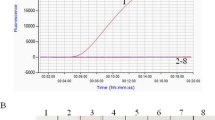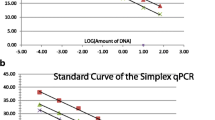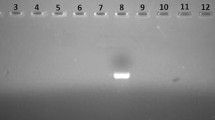Abstract
Escherichia coli O157:H7 is an important food-borne pathogen and has ability to contaminate food, such as water, meat products, and milk. Moreover, E. coli O157:H7 is the main toxin-producing serotype which can produce Shiga toxin type 1 and type 2 and cause intestinal disease. The strong pathogenicity and lethality of Escherichia coli O157:H7 pose a serious threat to human. This study aims to develop a rapid and visual detection assay of E. coli for rfbE, stx1, and stx2 genes by crossing priming amplification (CPA). The limit of detection of CPA assay for rfbE, stx1, and stx2 genes was 3.20 fg/μl, 320 fg/μl, and 320 fg/μl in genomic DNA, while that of in artificially contaminated food samples was 103 cfu/ml, 105 cfu/ml, and 105 cfu/ml, respectively, which was distinctly higher than that of PCR methods. And the specificity of CPA assay was tested by 22 different bacterial strains and except for E. coli O157:H7 ATCC43895 and other E. coli O157:H7 isolated from eggs, milk, and beef, all strains showed negative results. The visible detection assay was conducted by the addition of calcein in the reaction solutions. The CPA assay showed a successful detection of E. coli O157:H7 (Shiga toxin–producing and non-Shiga toxin–producing) within 60 min under 63 °C with high sensitivity and specificity. These results indicated that the CPA assays with calcein can provide an advanced method to achieve the rapid and visual detection of food-borne E. coli O157:H7.






Similar content being viewed by others
References
Abia ALK, Ubomba-Jaswa E, Schmidt C, Dippenaar MA (2018) Where did they come from-multi-drug resistant pathogenic Escherichia coli in a cemetery environment? Antibiotics (Basel) 7(3)
Davies, OL, & Chaib, F (2015) WHO’s first ever global estimates of foodborne diseases find children under 5 account for almost one third of deaths. In, vol. 2015)
Doyle MP (1991) Escherichia coli O157:H7 and its significance in foods. Int J Food Microbiol 12(4):289–301
Escherich T (1989) The intestinal bacteria of the neonate and breast-fed infant. 1885. Rev Infect Dis 11(2):352–356
Fischbach J, Xander NC, Frohme M, Glokler JF (2015) Shining a light on LAMP assays--a comparison of LAMP visualization methods including the novel use of berberine. Biotechniques 58(4):189–194
Law D (2000) Virulence factors of Escherichia coli O157 and other Shiga toxin-producing E. coli. J Appl Microbiol 88(5):729–745
Liu Y, Wang C, Tyrrell G, Li XF (2010) Production of Shiga-like toxins in viable but nonculturable Escherichia coli O157:H7. Water Res 44(3):711–718
Liu J, Zhou R, Li L, Peters BM, Li B, Lin CW, Chuang TL, Chen D, Zhao X, Xiong Z, Xu Z, Shirtliff ME (2017) Viable but non-culturable state and toxin gene expression of enterohemorrhagic Escherichia coli O157 under cryopreservation. Res Microbiol 168(3):188–193
Sharma VK (2006) Real-time reverse transcription-multiplex PCR for simultaneous and specific detection of rfbE and eae genes of Escherichia coli O157:H7. Mol Cell Probes 20(5):298–306
Sharma VK, Dean-Nystrom EA (2003) Detection of enterohemorrhagic Escherichia coli O157:H7 by using a multiplex real-time PCR assay for genes encoding intimin and Shiga toxins. Vet Microbiol 93(3):247–260
Wang G, Doyle MP (1998) Survival of enterohemorrhagic Escherichia coli O157:H7 in water. J Food Prot 61(6):662–667
Wang Y, Wang Y, Ma A, Li D, Ye C (2014) Rapid and sensitive detection of Listeria monocytogenes by cross-priming amplification of lmo0733 gene. FEMS Microbiol Lett 361(1):43–51
Wang YX, Zhang AY, Yang YQ, Lei CW, Cheng GY, Zou WC, Zeng JX, Chen YP, Wang HN (2018) Sensitive and rapid detection of Salmonella enterica serovar Indiana by cross-priming amplification. J Microbiol Methods 153:24–30
Xu G, Hu L, Zhong H, Wang H, Yusa S, Weiss TC, Romaniuk PJ, Pickerill S, You Q (2012) Cross priming amplification: mechanism and optimization for isothermal DNA amplification. Sci Rep 2:246
Yulong Z, Xia Z, Hongwei Z, Wei L, Wenjie Z, Xitai H (2010) Rapid and sensitive detection of Enterobacter sakazakii by cross-priming amplification combined with immuno-blotting analysis. Mol Cell Probes 24(6):396–400
Zhang H, Feng S, Zhao Y, Wang S, Lu X (2015) Detection of Yersinia enterocolitica in milk powders by cross-priming amplification combined with immunoblotting analysis. Int J Food Microbiol 214:77–82
Zhao X, Li Y, Wang L, You L, Xu Z, Li L, He X, Liu Y, Wang J, Yang L (2010) Development and application of a loop-mediated isothermal amplification method on rapid detection Escherichia coli O157 strains from food samples. Mol Biol Rep 37(5):2183–2188
Funding
This work was supported by the National Key R&D Program of China (2016YFD0400203), YangFan Innovative and Entrepreneurial Research Team Project (2014YT02S029), the National Key Research and Development Program of China (2016YFD04012021), Guangdong Special Support Program (2016TQ03N682), Pearl River S&T Nova Program of Guangzhou (201710010061), the Fundamental Research Funds for the Central Universities (Dr. Zhenbo Xu, D2191310), Collaborative grant with AEIC (KEO-2019-0624-001-1), the 111 Project (B17018), and Guangdong Province Key Laboratory for Green Processing of Natural Products and Product Safety (KL-2018-05, KL-2018-14, KL-2018-16).
Author information
Authors and Affiliations
Corresponding authors
Ethics declarations
Informed Consent
This is not applicable (humans are not involved).
Conflict of Interest
Zhenbo Xu declares that he has no conflict of interest. Yuting Luo declares that she has no conflict of interest. Thanapop Soteyome declares that he has no conflict of interest. Chii-Wann Lin declares that he has no conflict of interest. Xingyong Xu declares that he has no conflict of interest. Yuzhu Mao declares that she has no conflict of interest. Jianyu Su declares that he has no conflict of interest. Junyan Liu declares that she has no conflict of interest.
Ethical Approval
This article does not contain any studies with human participants or animals performed by any of the authors.
Additional information
Publisher’s Note
Springer Nature remains neutral with regard to jurisdictional claims in published maps and institutional affiliations.
Rights and permissions
About this article
Cite this article
Xu, Z., Luo, Y., Soteyome, T. et al. Rapid Detection of Food-Borne Escherichia coli O157:H7 with Visual Inspection by Crossing Priming Amplification (CPA). Food Anal. Methods 13, 474–481 (2020). https://doi.org/10.1007/s12161-019-01651-z
Received:
Accepted:
Published:
Issue Date:
DOI: https://doi.org/10.1007/s12161-019-01651-z




